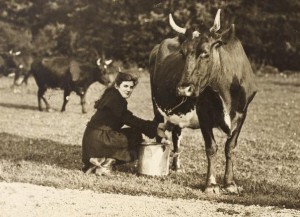 |
| Miss Mannix milking a cow at Charleville, Co. Cork in 1920 |
Folklores are everywhere. They make cultures unique and fun. Sometimes we think that folklores are only myths that existed in the past, but we can still see them around us today. For example, treating a cold with chicken soup is a folklore that still exists today (Funda, Kinkead, McNeill 251). Most of us didn’t learn that in school or a formal education class. In most cases, it was passed on orally. For example, I learned that from my grandmother, who had learned it from her mother. Folklores exist in all kinds of cultures and groups of people, and farming is no exception to that. In Farm: A Multimodal Reader, veterinarian Michael L. Doherty presents us with some Irish folklore that helps cure diseased cattle, which contributes to a unique Irish farm culture.
Irish farmers used many folklores to cure their cattle. Many of these “cures” were found in other counties, with a few tweaks that made it specific to that region in which it came from. For example, a folklore that was used to heal cows bleeding from haemorrhage or babesiosis was to use a person with the cure for bleeding in the county. Eight counties believed this, and all eight had the similarity that to cure the bleeding cow, you needed to consult with the person in the town/county that had the cure. However, all eight had differences too. For some counties, you needed to say a specific prayer, in some the person with the cure needed to know specific details about the cow. Why would each county have differences for the same cure? Most likely because the cure came from the same place, but as it was passed along from person to person and place to place, it was altered to the specific population.
Folklores tell us a lot about people. Which folklores a person believes in tells a lot about what they are like, what their family was like, and where they grew up. This contributes to our understanding of culture, of people, of daily life, etc. That is why it is important to study and read folklores (if you’re interested in understanding and appreciated something better.) This doesn’t just apply to farming folklores either, it can apply to all folklores.
Funda, Evelyn, and Lynne S. McNeill. "Farms and Folklore." Farm: A Multimodal Reader. Ed. Joyce Kinkead. Southlake: Fountain Head, 2014. 251-56. Print.
N.a. Miss Mannix Milking a Cow at Charleville, Co. 1920. National Library of Ireland, Charleville. Irish Archaeology. Web. 20 Feb. 2016.
No comments:
Post a Comment